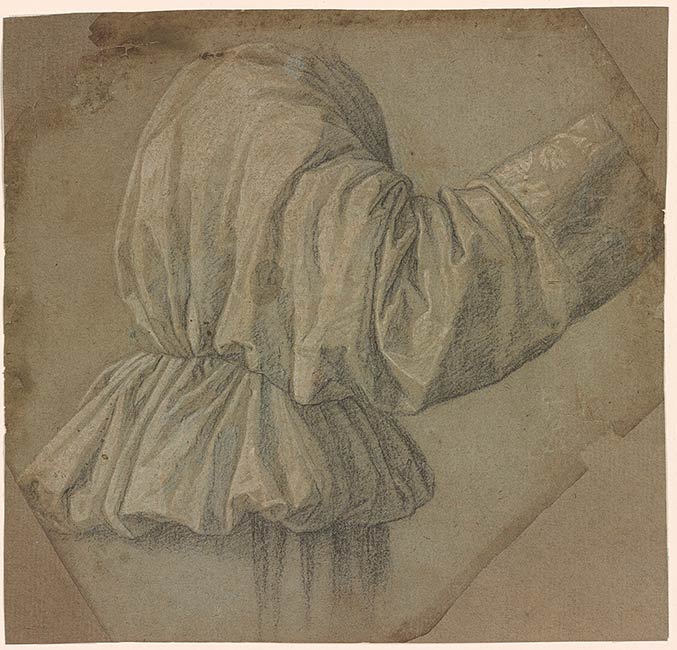
Catena, one of the most accomplished and successful late followers of Giovanni Bellini, perpetuated that master’s style into the second quarter of the sixteenth century. He was briefly in Rome a few months before his death in 1531 but was otherwise almost exclusively active in Venice from about 1500. An inscription on the back of Giorgione’s 1506 painting Laura in the Kunsthistorisches Museum, Vienna, refers to Catena as Giorgione’s colleague and thus indicates a relationship of some sort between the two.1 Catena produced numerous religious paintings and a few likenesses such as the Portrait of Doge Andrea Gritti (ca. 1523–31) in the National Gallery, London, and a portrait mentioned by the biographer Giorgio Vasari2 of a member of the Fugger family who resided at the Fondaco de’ Tedeschi in Venice.
The Morgan’s drapery study is the only drawing that may be given to Catena with certainty. As first recognized by Creighton Gilbert in 1956, it is preparatory for the tunic of the angel Gabriel in the large panel painting of the Annunciation to the Virgin (ca. 1515–17), formerly in the church of Santa Maria della Misericordia (also known as dei Bastardini) and now in the Museo Civico at Carpi.3 Previous to this identification, the drawing had been thought to be by one of the Lombard masters Giovanni Battista Moroni or Girolamo Savoldo, and, as Gilbert noted, the sheet thus attests to the closely related traditions of Venetian and Lombard art in the early sixteenth century. Following the traditions of the quattrocento, Catena arranged his gesturing yet subdued figure in profile, parallel to the picture plane. Omitting entirely any reference to the live human figure—the artist may have made use of a mannequin rather than a live model—Catena focused exclusively on the sensitively rendered, intricate folds of drapery, the fabric gathered at the waist, and the richly patterned brocade on the cuff, which in the painting radiates as a vibrant crimson set off against the dominant cool gray of the garment. The drawing anticipates the fall of light from the upper left in the painting and exhibits the tonal and sensuously luminous surface qualities that characterize the work of Catena’s Venetian contemporaries. Although Venetian Renaissance paintings demonstrate a pronounced fascination with the variation of tones and lights in drapery, pure drapery studies of this type—common in Florence and in Lombardy after Leonardo—are not often encountered among Venetian drawings, and Catena’s sheet is one of the rare specimens of this kind. Another contemporary example worth mentioning is the drapery study by Palma Vecchio at the Istituto Centrale per la Grafica, Rome, similarly executed on blue prepared paper.4
Of the drawings tentatively attributed to Catena, only two portrait studies in Berlin, also in black chalk with white heightening on blue paper, bear comparison with the Morgan’s sheet.5 A drawing of the Virgin and Child with the Infant St. John the Baptist in the Albertina6 that corresponds to an invention seen in several paintings by Catena7 is thought to be by a member of Catena’s workshop.8
—REP
Footnotes:
- For a recent summary of thoughts on that relationship, see Marciari 2015, 136–40.
- Vasari 1878–85, 3:643.
- Robertson 1954, no. 22; Carpi 1976, no. 7; Garuti 1990, 25–26.
- Istituto Centrale per la Grafica, Rome, inv. fc 125746. See Rome 1989, no. 3. A drapery study in the British Museum, London (inv. 1902,0822.4) formerly attributed to Vincenzo Catena and today given to the school or circle of Giovanni Bellini is an additional example, albeit one executed in oil on paper.
- Kupferstichkabinett, Berlin, KdZ 5067 and KdZ 5068. See Schulze Altcappenberg 1995, nos. 20–21.
- Albertina, Vienna, inv. 4872. See Birke and Kertész 1992–97, 3: no. 4872.
- See, for example, National Gallery, London, inv. ng 3540, or the version in the Museum Narodowe, Poznan.
- Robertson 1954, 77.
Watermark: none.
Inscribed on verso, at upper center, in pen and brown ink, "No[o superscript] 2(?)99 / (cancelled inscription) / Aless. Maggiori comprò ̣/ a Bologna dal sa cerdote Pancaldi / il giorno 24 Feb: / del 1796"; in lower center, in graphite, "RGC"; in red watercolor(?), 373; in lower right corner, in graphite, "N[o superscript] 127".
Pancaldi, Sacerdote, former owner.
Maggiori, Alessandro, 1764-1834, former owner.
Rey, A. Augustin (Adolphe Augustin), former owner.
Konstantinoff, former owner.
Scholz, János, former owner.
Rhoda Eitel-Porter and and John Marciari, Italian Renaissance Drawings at the Morgan Library & Museum, New York, 2019, no. 59.
Selected references: Gilbert 1956, 373; Venice 1957, no. 10; Bloomington and elsewhere 1958, no. 12; Oakland and San Francisco 1959, no. 18; Hagerstown 1960-61, no. 8; Newark 1960, no. 13; Staten Island 1961, no. 8; Cologne 1963-64, no. 37; New Haven 1964, no. 34; Bean 1965, 338; New York 1965-66, no. 41; Colorado Springs 1967, no. 1; London and elsewhere 1968, no. 21; New York 1971, no. 24; Washington and New York 1973-74, no. 92; Scholz 1976, no. 24; Rearick 2001, 47; Munich 2008-9, no. 8; Whistler 2016, 107; Marciari 2018a, 129.
Ryskamp, Charles, ed. Seventeenth Report to the Fellows of the Pierpont Morgan Library, 1972-1974. New York : Pierpont Morgan Library, 1976, p. 158.
Oberhuber, Konrad, and Dean Walker. Sixteenth Century Italian Drawings From the Collection of János Scholz. Washington, D.C. : National Gallery of Art ; New York : Pierpont Morgan Library, 1973, no. 92, repr. (includes previous bibliography and exhibitions).
Scholz, Janos. Italian Master Drawings, 1350-1800, from the János Scholz Collection, New York, 1976, no. 24, repr.
100 Master drawings from the Morgan Library & Museum. München : Hirmer, 2008, no. 8, repr. [Rhoda Eitel-Porter]
